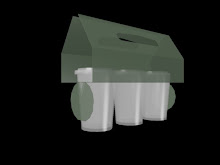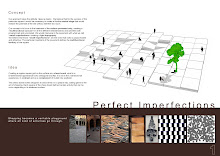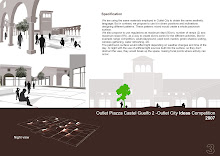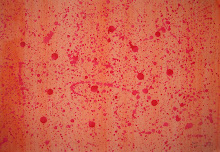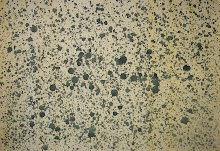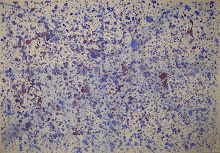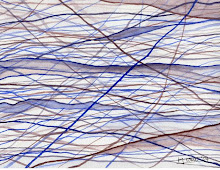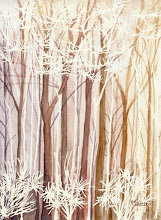El día de hoy debido al alto estréss en el que me veo envuelta he decidido escribir acerca del día día de un arquitecto. Habrá personas que se identifiquen con lo que escribiré y otras que no lo harán, esto será más bien un desahogo que algun artículo interesante que leer.
No es dificil encontrar un arquitecto perfeccionista, al contrario, los arquitectos nos caracterizamos por querer hacer cosas perfectas y por ser necios con nuestras ideas y conceptos. Esta perfeccion hace que TODO lo veamos mal. Decidimos pintar un muro de verde y cuando lo vemos pintado decidimos que era mejor opción haberlo pintado de azul. El caso es que nos la pasamos desacreditando lo que "alguien más hizo por nosotros". Porque no me van a decir que ustedes, tu arquitecto, tomaste una brocha y te subiste a un adamio a pintar un muro; no me vas a decir que pusiste periódico todo alrededor de "tu muro" verde para no pasarte con la pintura, ni tampoco me vas a decir que cargaste la cubeta para llevarla desde la tienda de pintura hasta el lugar deseado.
Mis comentarios van directamente para aquellas personas que ni cargan la cubeta, ni se suben al andamio, ni le llaman al pintor.... Y solamente llegan a decir que ESE MURO SE VERÍA MEJOR AZUL. Cuando ni si quiera estuvieron ahi para dar la orden de pintarlo!!
Es una crítica fuerte pero quisiera que las personas arquitectos que leen este blog eviten ser de los que no hacen nada pero siempre opinan que la solución del problema era otra que la misma que está ya hecha y terminada.
9.8.10
17.4.10
Art on Site

Now that I am having the great oportunity to design a huge building, I also have the experience of being on site every week. I happen to have a big passion for art either abstract paintings and sculptures. So I couldn’t avoid noticing the similarity between a real piece of art and, what I call, “circumstancial art”. In my last trip to San Francisco I went to the SFMOMA and there was a Richard Serra Sculpture presented on the terrace of the Museum. This sculpture, as all Serra’s steel sculptures, created an inner space and invited the admiror to surround the plates he created. Suddently I discover a spontaneous location of the formwork on Site that was very similar to what Serra did. I just wanted to share this with you and make you answer the next question: Is it the name of the artist what makes an art piece? Or can any spontaneous action become “circunstancial art” and be as good as a wellknown artist sculpture?
18.3.10
The Nasher Sculpture Center
 As a great fan of Renzo Piano I could not have been to the Nasher Sculpture Center without writing my experience about it. I am always amazed with the perfect details I have seen in Renzo’s work and this time what captured my attention was the modularity of these architectural spaces.
As a great fan of Renzo Piano I could not have been to the Nasher Sculpture Center without writing my experience about it. I am always amazed with the perfect details I have seen in Renzo’s work and this time what captured my attention was the modularity of these architectural spaces.It is all about proportions and space. In the Nasher, the four naves linked with an outstanding roof are totally
This museum is so simple and perfect, that it might very well fit in the minimalism definition. It couldn’t have been another way; the art sculpture pieces couldn’t have fitted in another kind of spaces. The four naves are kind of a wall that you have to cross through to arrive into The Wonderland of sculpture. A virtual space located in between the street and the Garden. And through this Garden of Sculptures is where you discover art, landscaping and architecture merged in one space.
It’s incredible to feel the tranquility that this garden has. For me it was kind of Disney world where each sculpture transmitted me some kind of an amazing emotion. James Turrel sculpture was my favorite. It was literally like entering into another dimension: perfect weather, perfect sound. And, as view: the sky, only the sky. This was certainly a good experience for March 2009.
15.12.08
Now working
11.3.08
Graffiti Art

Suddenly the graffiti art has accomplished a very respectful place. It has become the voice of people and a way of expressing a common feeling of the citymakers. For years graffiti represented the sentenced art, a painting that most not be there, a result of vandalism. The artist is not an artist it’s a non respectful person that has no education and was not taught to respect others wall.
In my opinion what makes a graffiti an artwork is the whole concept of it. First, you have to choose the place for the painting, second, you have to choose the perfect time to do it and, while doing it, be aware that nobody sees you. It seems so wrong but in the end you need a lot of braveness and technique to be into it and practice it frequently.
Another positive characteristic of graffiti art is the language that expresses. I heard there are groups that establish a proper language and they send messages through their drawings. They even have a special signature that distinguishes each group. So people that are really into it may say as we, art lovers do: look! It’s a Pollock. Or wow! Have you seen the Picasso in the corner between the third and the x avenue? Or what about our beloved Bansky, who dialogues with people through graffiti and ads an ironic significance to the writings and paintings by suggesting the perfect spot to take a beautiful tourist photo.
Particularly, in Mexico we have developed a lot of graffiti makers that are called “pandillas” or gangs and are considered vandals and dangerous. But very strange, the last month the Social Security System in Mexico City thought about a very interesting solution to
There is a famous stadium of football located in the south of Mexico and all the surrounding walls were inevitably covered by graffiti paintings. On a heavenly inspiration, someone suggested to allow graffiti makers to paint in the walls but in a legal way. And it worked!. About 300 young artists did a good work and today you can go to the stadium and have even an historic story about the most significant events that have had taken place in this stadium. I think that government initiative didn’t just helped graffiti but also encouraged the Mexican creativity and promote artistic expression. It also has, as antiques paintings, a lot of information about Mexican lifestyle and costumes. I think in Mexico we need more social initiatives like this to add diversity and spontaneity to normal life.
1.2.08
Crack

A crack in the wall, a crack in the ceiling, a crack in the floor... This can appear as an inevitable sign of age in a building or in a street but ironically today is becoming a way of talking. A way of claiming and showing what is happening in the world as a phenomenon.
It’s what arthas become into. It’s what art is now claiming. Modern artists are not interested in creating new forms or using new materials. They are offering to the world what it has created among years.
Doris Slacedo is provocative and strategic; an artist and a revolutionary. She got the perfect spot to pronounce her speechless speech. A scar that cannot be healed, not even time can make it disappear. The image of the world falling apart is what she conceived using a natural sign of age. She speaks about society, difference of worlds that are always going to be divided. Maybe she is thinking of the abyss that exist between poverty and richness, maybe she is thinking about racism, maybe she is thinking about the third world and the first world countries. Maybe it is a little bit of everything.
It’s a concept so profound that has been materialized in a very simple thing but so accurate. For me it was incredible to find an artificial crack appearing so natural. And it was much more surprising to find this event occurring in such an emblematic place.
London; one of the most expensive Cities in the world with one of the most named Monarchy still existing. The Tate Modern Gallery restored by one of the most named architects nowadays.
You have to be there to experience what is all about. It is a piece of art that is now part of the permanent exhibition of the Tate Modern Gallery.
It’s what art
Doris Slacedo is provocative and strategic; an artist and a revolutionary. She got the perfect spot to pronounce her speechless speech. A scar that cannot be healed, not even time can make it disappear. The image of the world falling apart is what she conceived using a natural sign of age. She speaks about society, difference of worlds that are always going to be divided. Maybe she is thinking of the abyss that exist between poverty and richness, maybe she is thinking about racism, maybe she is thinking about the third world and the first world countries. Maybe it is a little bit of everything.
It’s a concept so profound that has been materialized in a very simple thing but so accurate. For me it was incredible to find an artificial crack appearing so natural. And it was much more surprising to find this event occurring in such an emblematic place.
London; one of the most expensive Cities in the world with one of the most named Monarchy still existing. The Tate Modern Gallery restored by one of the most named architects nowadays.
You have to be there to experience what is all about. It is a piece of art that is now part of the permanent exhibition of the Tate Modern Gallery.
It seems that the huge hall with enormous height provoked a natural crash that is growing. It reminds me the movies where the hero is standing in the middle of two rocks that are dividing in two parts. It can be part of a fiction movie in which you have to take part of the strongest side of the rock to survive. Otherwise you will fall to the abyss.
But it is not that, it is a quiet crash that has been created with hands and care. Doris must have had done a profound study of cracks, how they begin and how they take their natural course. I really don’t know how she managed to get the approval of the Authorities, and I cannot conceive how she created that perfect crack to appear so fucking natural.
And its going to be there forever because not even a refuel of the same material will be able to delete that sign. And it was meant to be like that. It was designed for her not to be erasable.
It is amazing, I really applause her for what she has done, I think the purity of a social problem has become an art installation in the Tate Modern Gallery. I bet this is the perfect example of how loud can it be a simple and quiet intervention.
And its going to be there forever because not even a refuel of the same material will be able to delete that sign. And it was meant to be like that. It was designed for her not to be erasable.
It is amazing, I really applause her for what she has done, I think the purity of a social problem has become an art installation in the Tate Modern Gallery. I bet this is the perfect example of how loud can it be a simple and quiet intervention.
Beyeler Foundation

One of the most impressive experiences for the people that love art is the fact of being in a space that makes you tremble not just in one but in three dimensions. In one dimension for the piece of art that you are looking, and in three for the space itself that makes you admire that piece of art.
Ernst Beyeler couldn’t have done less than ask one of the best architects of the time to design a museum in which he could expose the collection of art that he has.
Renzo Piano materialized the desire of an art sponsor creating appropriate spaces for admiring and exhibiting great sculptures and paintings.
I consider the responsibility of the architect is not all about spaces and scale but also to dignify the art itself when it is exposed.
Practically, maybe Yoshio Taniguchi understood the new formats of the abstract art and proposed bigger scales for the art observation inside a Museum. The New York Museum of Modern Art MOMA, in spite of the controversial points of view, answers to a specific need that ancient museums didn’t take in consideration in their architectural programs. The game between heights and bridges creates a proper space to host paintings and sculptures of a bigger scale and helps the observation of those pieces from different views. In my opinion this space enriches the perception of the objects. Nevertheless, a very bad example of space linked to observation of art is the Reina Sofia Museum in Spain, where Picasso’s Guernica can never be viewed the whole; not even at one single point of the space. It is almost a sin to pass through without noticing that the piece of art by your side is one of the most important creations of the big format artistic expression.
And I am taking about last two examples because the way of presenting a big piece of art in the Beyeler Foundation Museum is, in my opinion, extraordinary. It seems that the space itself could help to keep the attention to the paintings and also could keep time from passing by in a Museum Gallery.
Talking about sensations this museum allows you to observe, invites you to do it and surprises when you are doing it.
There is an interesting interaction between wall-window to limit the space so as the furniture used. The composition of landscape-art, nature-art, humancreation-artpiece feed the eyesight and pleases the body.
One of the most surprising spaces is the corridor-façade that Renzo Piano is proposing. It seems that Switzerland Nature had composed such a perfect piece of art to be admired, and the architect, recognizing that valuable nature piece did complement the Beyeler Collection with the contemplation of it. Sit down and see! Can clearly be the order of this space designer.
Another situation that further on impresses the most is a little cottage that you can admire in the landscape. A landscape that is framed by the façade and the museum is inviting you to observe. It seems that the "feriehaus"has merged in the green Alps landscape and was there to transform the nature into a piece of art with a more spontaneous image and with the dignity to be admired. People that have lived this space somehow envy the owner of that cottage, and we may desire to spend at least one afternoon in that house. Thank God we have Beyeler Museum to sit down and contemplate the sunset… with a nice cottage in a front plane.
Ernst Beyeler couldn’t have done less than ask one of the best architects of the time to design a museum in which he could expose the collection of art that he has.
Renzo Piano materialized the desire of an art sponsor creating appropriate spaces for admiring and exhibiting great sculptures and paintings.
I consider the responsibility of the architect is not all about spaces and scale but also to dignify the art itself when it is exposed.
Practically, maybe Yoshio Taniguchi understood the new formats of the abstract art and proposed bigger scales for the art observation inside a Museum. The New York Museum of Modern Art MOMA, in spite of the controversial points of view, answers to a specific need that ancient museums didn’t take in consideration in their architectural programs. The game between heights and bridges creates a proper space to host paintings and sculptures of a bigger scale and helps the observation of those pieces from different views. In my opinion this space enriches the perception of the objects. Nevertheless, a very bad example of space linked to observation of art is the Reina Sofia Museum in Spain, where Picasso’s Guernica can never be viewed the whole; not even at one single point of the space. It is almost a sin to pass through without noticing that the piece of art by your side is one of the most important creations of the big format artistic expression.
And I am taking about last two examples because the way of presenting a big piece of art in the Beyeler Foundation Museum is, in my opinion, extraordinary. It seems that the space itself could help to keep the attention to the paintings and also could keep time from passing by in a Museum Gallery.
Talking about sensations this museum allows you to observe, invites you to do it and surprises when you are doing it.
There is an interesting interaction between wall-window to limit the space so as the furniture used. The composition of landscape-art, nature-art, humancreation-artpiece feed the eyesight and pleases the body.
One of the most surprising spaces is the corridor-façade that Renzo Piano is proposing. It seems that Switzerland Nature had composed such a perfect piece of art to be admired, and the architect, recognizing that valuable nature piece did complement the Beyeler Collection with the contemplation of it. Sit down and see! Can clearly be the order of this space designer.
Another situation that further on impresses the most is a little cottage that you can admire in the landscape. A landscape that is framed by the façade and the museum is inviting you to observe. It seems that the "feriehaus"
Suscribirse a:
Entradas (Atom)



